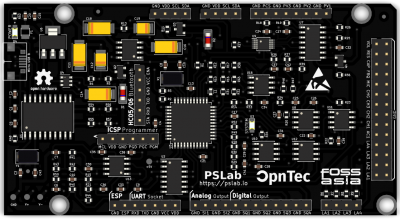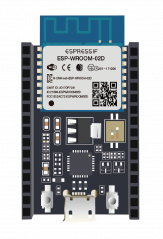Difference between revisions of "Pocket Science Lab Kit"
(add a basic structure) |
(add dummy text; image positioning) |
||
| Line 1: | Line 1: | ||
[[File:PSLab v5 top.png|thumb|right|400px||Pocket Science Lab Kit Top View]] | |||
== Summary == | == Summary == | ||
| Line 4: | Line 6: | ||
== Description == | == Description == | ||
[[File:ESP-WROOM-02U.png|thumb|right|163px||ESP8266 DevKitC V1]] | |||
This board allows you measure all kinds of things, assumed you have the right sensor and it is supported. Basic connectors/sensors are USB, GPIO Connector, UART,Wi-Fi, Bluetooth, I2C and ICSP Programmer. A full list of the technical specifications can be found in the data sheet A as well as on the PS Lab website. A built-in Oscilloscope, Power Source, Multimeter, Accelerometer, Sensors, Logic Analyzer and Wave Generator can be used right out of the box. A Temperature Sensor, Compass, Barometer and Lux Meter need extra sensors. | |||
=== Functionalities === | === Functionalities === | ||
The application has a user friendly interface. From a list of various functions can be | |||
selected. The structure is more or less the same for the functions. In the center is either | |||
a graph or any other visual representation. On the right hand side is a panel where | |||
parameters and triggers can be set. Each function has the ability to record the received | |||
input. Therefore a Rec-Button will appear on the top right corner. The recording can | |||
be started by clicking on it and stopped by clicking another time on it. The menu has | |||
a section with ”Logged Data”. In this section the recording can be found and exported | |||
as .csv file. | |||
The following table 2.1 will cover all functionalities of the Android application in com- | |||
bination with the board. Some functions are available without additional hardware. In | |||
the first half of the table are functions listed which do not need extra hardware. The | |||
second half requires additional hardware to make use of the capabilities from the board. | |||
Disappointing is the fact that not all of the listed functionalities are available on the | |||
desktop or android version and are not even supported/implemented in the firmware. | |||
Only these functions are available: Oscilloscope, Multimeter, Logical Analyzer, Wave | |||
Generator, Power Source and Robotic Arm Controller. | |||
=== Sensors === | === Sensors === | ||
Notable sensors are the temperature sensor, gas sensor and | |||
moisture sensor. By adding a temperature sensor 2.1 to your | |||
PS Lab Kit you can for example always check the temperature | |||
of your greenhouse and create history of the measured data. | |||
This helps you to check if the cooling/heating is working prop- | |||
erly. With a gas sensor 2.2 you can create a smoke detector | |||
which can alert you if there is smoke development or a object | |||
is burning. A moisture sensor 2.3 can close your windows if its | |||
raining outside. | |||
=== Wi-Fi === | === Wi-Fi === | ||
The ESP-WROOM-02U is a Wi-Fi module working on the 2.4 | |||
GHz range. The female header pins allow a easy connection to | |||
the I/O ports. ... | |||
== Use Cases == | == Use Cases == | ||
| Line 19: | Line 53: | ||
=== Multimeter === | === Multimeter === | ||
Multimeter text. | |||
=== Oscilloscope === | === Oscilloscope === | ||
Oscilliscope text. | |||
== Used Hardware == | == Used Hardware == | ||
Revision as of 20:07, 23 November 2020
Summary
The Pocket Science Lab Kit is a small USB-based hardware extension for an Android device or PC, which allows the use of different instruments / functions that are already integrated in the board or can be expanded via external sensors. It is aimed at everyone whether teacher, pupil, hobbyist, student, professor or scientist. The name Pocket Science Lab says it all. The user has a small scientific laboratory in the size of a pocket. The aim of the Pocket Science Lab project is to perceive one's environment better and to digitize the analog world.
Description
This board allows you measure all kinds of things, assumed you have the right sensor and it is supported. Basic connectors/sensors are USB, GPIO Connector, UART,Wi-Fi, Bluetooth, I2C and ICSP Programmer. A full list of the technical specifications can be found in the data sheet A as well as on the PS Lab website. A built-in Oscilloscope, Power Source, Multimeter, Accelerometer, Sensors, Logic Analyzer and Wave Generator can be used right out of the box. A Temperature Sensor, Compass, Barometer and Lux Meter need extra sensors.
Functionalities
The application has a user friendly interface. From a list of various functions can be selected. The structure is more or less the same for the functions. In the center is either a graph or any other visual representation. On the right hand side is a panel where parameters and triggers can be set. Each function has the ability to record the received input. Therefore a Rec-Button will appear on the top right corner. The recording can be started by clicking on it and stopped by clicking another time on it. The menu has a section with ”Logged Data”. In this section the recording can be found and exported as .csv file.
The following table 2.1 will cover all functionalities of the Android application in com- bination with the board. Some functions are available without additional hardware. In the first half of the table are functions listed which do not need extra hardware. The second half requires additional hardware to make use of the capabilities from the board. Disappointing is the fact that not all of the listed functionalities are available on the desktop or android version and are not even supported/implemented in the firmware. Only these functions are available: Oscilloscope, Multimeter, Logical Analyzer, Wave Generator, Power Source and Robotic Arm Controller.
Sensors
Notable sensors are the temperature sensor, gas sensor and moisture sensor. By adding a temperature sensor 2.1 to your PS Lab Kit you can for example always check the temperature of your greenhouse and create history of the measured data. This helps you to check if the cooling/heating is working prop- erly. With a gas sensor 2.2 you can create a smoke detector which can alert you if there is smoke development or a object is burning. A moisture sensor 2.3 can close your windows if its raining outside.
Wi-Fi
The ESP-WROOM-02U is a Wi-Fi module working on the 2.4 GHz range. The female header pins allow a easy connection to the I/O ports. ...
Use Cases
The following list consists of some basic use cases of the kit.
Multimeter
Multimeter text.
Oscilloscope
Oscilliscope text.

